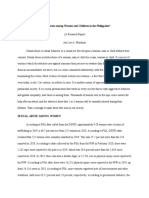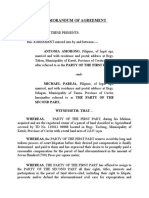Case Study Bullying
Uploaded by
aloy1980Case Study Bullying
Uploaded by
aloy1980Bullying is one of the problems that we have in school.
One
of your pupils gets teases for her new haircut. Or a pupil comes
to you showing a page of his book ripped off by his classmate. I
believe that teasing and roughhousing are but part and parcel of
a school setting. But more often than not, these are rare and
isolated cases.
The short-term effect of bullying is that the victim develops
school phobia. Because of the stress and humiliation he regularly
suffers in school, the victim would rather stay in the security of
his own home.
There is a mother who happened to be a friend of mine has a
problem with her first grade daughter who has been complaining
about her classmates that bullied her. Her daughter even got
home one day with her uniform colored with crayons at the back.
One day with her school bag tore and she even complained that 3
boys drag her outside the classroom and pushed her down and
her crayons were gone not just once but every time she got new
sets of crayons almost half of it were gone the day she brought it
with her in school.
Since she was working abroad, several miles away from her
daughter and had only her mother to talk to the teacher but she
only got "okay but I cannot control these kids, it is hard to
discipline children nowadays because we have DSWD that would
sue us" answer from her teacher. Shouldn't they do something
about this bullying? Isn't there a law that would regulate this? She
is only 7 years old and yet she had to experience all this kind of
bullying. When she got home from Singapore she did come to her
daughters class one day and talk the child whom her daughters
other classmates pointed as one of those bullies. She told him
that if he continues to do it she would have him called at the
principal office since their teacher seems not to mind the bullying
in her classroom.
A week after it the school held a general meeting with the
PTA and tackles this bully issue. It is weird because the principal
herself says that parents cannot directly complain to her office
until we got solid evidence that our child is being bullied. What
evidence should parents have to wait for? Should they wait for
their kids to get home with bruises and black eyes or clothes torn
just to have the evidence they are looking for?
Objectives
1. To find out
how bullies manifest their bullying
activities.
2. To elucidate the personal circumstances of bullies.
3. To determine the effect of the bullied victims.
4. To come up some possible solutions to prevent the
development of bullies in schools.
Findings of the Study
1. Forms of bullying mostly indulged in were excessive teasing,
extortion (food, money, and belongings), physical injuries the
use of ball pens and pencils to stab the victim is common
especially among bullies from the elementary level.
2. In the primary of the elementary levels, excessive teasing and
slight physical injuries were common. As the bullies developed,
they resorted to more sophisticated forms like extortion,
intimidation, and more serious physical injuries.
3. Most of the identified bullies belonged to poor families where the
parents were seldom present. They are neglected and left to fend
for themselves.
4. As reflected, family discord was the major factor that contributed
to bullying. Aggressive parents produce bullies because they
inadvertently teach them anti-social behavior. Misconception on
the true nature of bullying was also found to be contributory to
bullying. Some adults and school authorities regard bullying as a
natural part of growing up among children and therefore deserves
no serious considerations. Unchecked early signs of aggressive
behavior is another factor that contributed to the prevalence of
bullying. Acts of violence and aggression in the home which were
condoned were also causes of bullying.
5. Most of the bullying incidences happened in the playground,
deserted dark places, behind buildings, and in the comfort rooms
where students are least supervised. It may also take place in the
classrooms, when the teachers are not looking.
6. Most of the bullies reasoned out that they bullied the victim
because they provoked them. Some school authorities admitted
that the bullies took the initiative because they were just joking.
Others said they just defended themselves. They bully seldom
admitted that he did the activity just to have fun in seeing others
suffer, and for selfish motives.
7. Unhappy home environments are very good breeding places for
bullies. Parents contribute much to the maturing bullies. In
general, the bully is greatly influenced by his environment and
living conditions.
8. The home and parents contribute much to the breeding of both
bullies and victims. Forms of bullying and places where they are
manifested vary according to the age levels of the bullies.
9. The socio-economic status of a family has not consistently been
found to be the cause of aggression among its children.
10.
Children model themselves on adults who are significant to
them, like their parents, elder brothers, and teachers. Most of the
identified bullies come from homes with violent aggressive
members.
11.
Playing favorites among children enhances aggression and
passivism, thus producing bullies and victims.
Recommendations
1. Parents should made aware of their lions share in the production
and prevention of bullies in their violent quarrels between them
which serve as bad models for the child. Neglecting to check
aggressive, violent reactions encourages the behavior.
2. Closer supervision of students is warranted to prevent unpleasant
consequences of bullying, especially during playtime either in
school or at home.
3. Send children to play groups.
Seek reassurance on the
qualification and training of those in charge.
4. Do not expose children to violent games, or their aggressive
behavior will be reinforced. Sports where they will be competing
with themselves are better than those which will involve
competition with others.
5. Parents should not encourage the behavior of a bully by giving in
to whatever he demands. They should seek help from experts on
child behavior.
6. Provide for non-verbal communication to express a childs
personality, like engaging in the arts, music, drawing, drama,
writing, and other activities as may suit his particular needs.
7. Television shows and programs should be carefully selected.
Those which are too violent should be avoided. The child tends to
imitate what he sees.
8. Childrens behavior at home and in school should be closely
supervised so that any behavior or instance of being aggressive
and violent could be addressed immediately.
9. Parents should avoid quarreling in the presence of their children,
especially serious ones, when the father has to hit his wife.
Scenes like these affect the personality of their children. They
harbor bad feelings which may be the cause of their violent and
aggressive behavior.
10.
Provide a child with a controlling environment where there
are rules and regulations to determine his behavior.
11.
There should be corresponding actions for whoever either
breaks or obeys the regulations, without which they will be
ineffective.
12.
Schools should have anti-bullying policies stating that
bullying is wrong and that it will not be tolerated. The policies
have to be broached in such a way that every member of the
school adopts them. They must pervade the curriculum and be
embodied as clear principles in the life of the schools.
13.
Bullies should be given opportunity to attend special
counseling sessions; special programs should be implemented to
help recognize their feelings, as well as the feelings and behavior
of others.
14.
Provide a safe and caring environment for the bully but with
firm boundaries and control.
15.
As much as possible prevent angry outbursts of aggressive
children. This can be done by communicating with them regularly
on issues which may arouse their anger.
16.
Give the bully work opportunities only within his capability to
avoid frustration on his part. Failure cannot be tolerated by a
bully, as this appears to him as a threat.
17.
When speaking to a bully, do not swear words, nor deride his
appearance, or mock his friends. Criticism and rejection promote
his violent reactions.
18.
In school and at home, bullies should not be embarrassed in
front of others. If they need confrontation it should be done in
private.
You might also like
- Proven Tips To Quickly Remove Late Payments From Your Credit Report100% (2)Proven Tips To Quickly Remove Late Payments From Your Credit Report5 pages
- Chapter 2 - Review of Related Literature and StudiesNo ratings yetChapter 2 - Review of Related Literature and Studies20 pages
- Campus Bullying in The Senior High School A Qualitative Case Study100% (1)Campus Bullying in The Senior High School A Qualitative Case Study9 pages
- Academic Track and A Humss Strand: Iii Summative Test100% (2)Academic Track and A Humss Strand: Iii Summative Test1 page
- Survey Questionnaire On Bullying of XYZ SchoolNo ratings yetSurvey Questionnaire On Bullying of XYZ School10 pages
- Bullying in The Philippines Is Widespread in Schools and Over The Internet50% (2)Bullying in The Philippines Is Widespread in Schools and Over The Internet11 pages
- Pros or Cons? Effects On Anti-Bullying Act of 2013 Towards Senior High School StudentsNo ratings yetPros or Cons? Effects On Anti-Bullying Act of 2013 Towards Senior High School Students2 pages
- Module On Child Protection Policy: Prepared by100% (3)Module On Child Protection Policy: Prepared by11 pages
- The Effect of Bullying To The Academic Performance of The Learner - FinalNo ratings yetThe Effect of Bullying To The Academic Performance of The Learner - Final11 pages
- Sexual Abuse Among Women and Children in The Philippines (Research Paper in English)No ratings yetSexual Abuse Among Women and Children in The Philippines (Research Paper in English)7 pages
- Questionnaire Name: (Optional) School: Directions: Please Answer The Questions Based On Your Opinion Following The Below Rating Scale100% (5)Questionnaire Name: (Optional) School: Directions: Please Answer The Questions Based On Your Opinion Following The Below Rating Scale3 pages
- Awareness and Prevention of Bullying Among Students of GGNHS100% (1)Awareness and Prevention of Bullying Among Students of GGNHS35 pages
- AConceptPaperabouttheAnti BullyingLawanditsImplicationsNo ratings yetAConceptPaperabouttheAnti BullyingLawanditsImplications57 pages
- How To Make A Conceptual Framework (With Samples)No ratings yetHow To Make A Conceptual Framework (With Samples)5 pages
- Philippine Guidance and Counseling Association100% (1)Philippine Guidance and Counseling Association11 pages
- Journal of The Thesis About Sexual Harassment 2012-201350% (4)Journal of The Thesis About Sexual Harassment 2012-201318 pages
- Bullying: Impacts To The Students Learning: Literature Review of Bullying at SchoolsNo ratings yetBullying: Impacts To The Students Learning: Literature Review of Bullying at Schools9 pages
- Department of Education: Community Engagement, Solidarity and CitizenshipNo ratings yetDepartment of Education: Community Engagement, Solidarity and Citizenship3 pages
- Bullying Experiences of Selected Grade 12 Students at Catanduanes National High SchoolNo ratings yetBullying Experiences of Selected Grade 12 Students at Catanduanes National High School44 pages
- "Catcalling Aren'T Compliments": The Impact of Catcalling in Female Teenager in Selected Student in Liceo Del Verbo DivinoNo ratings yet"Catcalling Aren'T Compliments": The Impact of Catcalling in Female Teenager in Selected Student in Liceo Del Verbo Divino6 pages
- The Impact of Bullying On The Adolescence Stage of A Student in Saint Mary Magdalene COLLEGES OF LAGUNA S.Y. 2019-2020No ratings yetThe Impact of Bullying On The Adolescence Stage of A Student in Saint Mary Magdalene COLLEGES OF LAGUNA S.Y. 2019-202022 pages
- Forces Operating Within A Group in Social Interaction0% (1)Forces Operating Within A Group in Social Interaction15 pages
- Street Harassment, Self-Esteem and Self-ObjectificationNo ratings yetStreet Harassment, Self-Esteem and Self-Objectification47 pages
- Republic of The Philippines Department of Education Bureau of Public Schools Division of Zamboanga Sibugay Report On Secondary PromotionsNo ratings yetRepublic of The Philippines Department of Education Bureau of Public Schools Division of Zamboanga Sibugay Report On Secondary Promotions2 pages
- Schools and Cooperative Learning - Theories, Models, and Strategies-Routledge (1995)100% (17)Schools and Cooperative Learning - Theories, Models, and Strategies-Routledge (1995)489 pages
- The John Sanders Memorial Competition For Young ComposersNo ratings yetThe John Sanders Memorial Competition For Young Composers2 pages
- The Spread of Caribbean Culture - MigrationNo ratings yetThe Spread of Caribbean Culture - Migration12 pages
- Impact of Poor Nutrition On The Academic PerformanNo ratings yetImpact of Poor Nutrition On The Academic Performan13 pages
- Ecofeminist Concern: Woman As Savior and Nurturer of Nature Sowmya L GNo ratings yetEcofeminist Concern: Woman As Savior and Nurturer of Nature Sowmya L G6 pages
- Resolution No. 14-Bunawan Water District Reservoir100% (2)Resolution No. 14-Bunawan Water District Reservoir2 pages
- Website and Marketing Analysis of Tommy HilfigerNo ratings yetWebsite and Marketing Analysis of Tommy Hilfiger2 pages
- Last 6 Month Vocabulary Magazine by Nimisha Ma'Am January To JuneNo ratings yetLast 6 Month Vocabulary Magazine by Nimisha Ma'Am January To June175 pages
- Role of Female Character in Shakespearean Dramas: Ritu RatheeNo ratings yetRole of Female Character in Shakespearean Dramas: Ritu Rathee7 pages
- Reading and Writing Skills: Quarter 3 - Module 260% (5)Reading and Writing Skills: Quarter 3 - Module 222 pages
- Business Development Manager Research in Chicago IL Resume Christine HorwitzNo ratings yetBusiness Development Manager Research in Chicago IL Resume Christine Horwitz2 pages





























































































